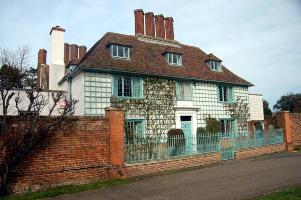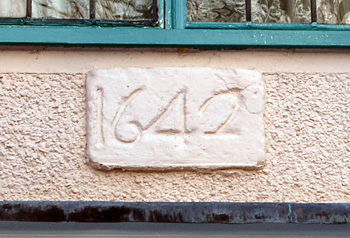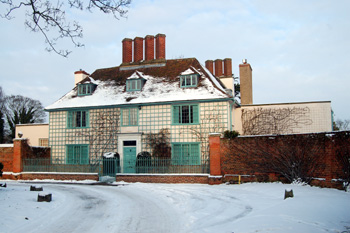Howard House Cardington

Howard House in March 2007
A property in Cardington described as "a capital messuage in Church End, Cardington, formerly in occupation of Walter Wilcox, gentleman and Lady Mordant, now Nathaniel Taylor, esquire" was conveyed by bargain and sale on 13th February 1654 by George Orlybeare [Orlebar] of Harrold and John Cleaton of Cardington to William Bridges of Hackney [Middlesex] along with a close of five roods separated from the house by "a common lane".
This property is first referred to as The Black and White House in a feoffment [conveyance] of 22 May 1674 when it was sold, along with the five rood close by George Ingram, Nathaniel Taylor, John Tulidah and Francis Bridges (presumably executors or trustees of William Bridges) to Stephen Whitbread for £115. It is then described as "a messuage commonly called the Black and White House, in occupation of Robert Stanton between a cottage in occupation of John Peake to the west and a cottage in occupation of John Cranfield to the east". On 3 Aug 1728 the house was sold by John Whitbread of Katherine Wheel Alley, Whitechapel, a silk thrower (great nephew of the now deceased Stephen Whitbread) to Robert Pemberton of Cardington for £84. The description makes it clear that this is the same house as that sold in 1654 by its description "A capital messuage commonly called the Black & White House in Church End, Cardington, formerly in occupation of Walter Wilcox and Lady Mordant, then Nathaniel Taylor then Robert Staunton [sic] then Stephen Whitbread now Robert Pemberton between a cottage of Dr.Atterbury formerly in occupation of John Cranfeild east and a cottage of John Browne, formerly in occupation of John Peake west with a common lane north and the common street south".
Robert Pemberton left the house in his will to his wife Ann who sold it on 10 Sep 1732 to John Garrett of Cardington and his wife Alice. This John Garrett was also known as John Galiegan and he mortgaged the house, along with other property to William Harris of Bedford in 1753 for £80. Evidently John Garrett alias Galiegan died that same year or the next because we find a letter of attorney of 23 Apr 1754 from his brother Francis Galiagan of Jamestown, Meath [Ireland] appointing their other brother Mathias, also of Jamestown, to be his attorney in settling John's estate. Thus on 4 Jun 1754 Francis Galiagan, through his brother Francis, feoffed [conveyed] the Black and White House, amongst other property, to John Harris of Bedford, paying off the mortgage to William Harris.
It is here that the story of the house gets particularly interesting because on 9 Apr 1757 William Harris sold the Black and White House (now inhabited by Thomas Walker and Thomas Preston), along with other property to John Howard, the famous prison reformer and man of Cardington (though then living at St.Paul's Churchyard, London), with Ive Whitbread of Dowgateshill, London acting as Howard's trustee, the price being £220.10s.
This sale makes it clear that the Black and White House is, in fact, Howard House. This house has always been assumed to have been built by John Howard in about 1760 (the entry in the List of Buildings of Special Architectural or Historic Interest as well as the entry in the Guide of the Buildings of Bedfordshire and the County of Huntingdon & Peterborough by Nicolaus Pevsner state as much) but the references here indicate that John Howard bought a substantial house (a "capital messuage") in Church End in Cardington in 1757. This house had a lane at the back (to the north) and the common street to the south. Howard House has a short lane at the rear and faces onto the road running round the churchyard. It seems inconceivable that Howard would have bought two such substantial houses in such a similar situation in Cardington. The final piece of evidence lies in a date stone found some years ago by the late Humphrey Whitbread, who lived at Howard House, in his garden. He had the stone, bearing the date 1642, set into the front of the house.

The date stone at Howards House Christmas Eve 2010
What seems to have happened is that a large house was built facing the graveyard in 1642 and, because it was half timbered ,with the timbers painted black and the mortar painted white, it became known as the Black & White House. We tend to assume that all half timbered buildings were painted black and white but this was, in fact, rare outside such western counties as Herefordshire, the wood and mortar usually being left in their natural brown and beige, so a black and white design would be unusual enough in Bedfordshire to be remarked upon at the time.
This was the house purchased by John Howard in 1757. It is quite likely that he then either demolished it and rebuilt it (hence the discarding of the date stone as a garden ornament) or, at the least, very substantially remodelled it, perhaps leaving only the core of the original building. Which of these two things occurred can only be addressed by an expert in vernacular architecture and/or by such methods as dendro-chronology (examination of tree rings).
John Howard lived in the house with his second wife Henrietta. Her health, however, was poor and the couple moved to Hampshire for a while, before moving back to the house when the better climate on the south coast had no beneficial effect. Henrietta bore John a son but died in 1765. John Howard continued to use Howard House as a base until his death in Kherson in Ukraine in January 1790, though he must often have been absent, visiting prisons in England and Europe. His son died in an asylum in Leicester in 1799 having been an inmate for thirteen years.
In 1782 schoolmaster James Lilburne undertook a house by house survey of Cardington, giving details of each resident family. John Howard was recorded as living at Howard House but no details of those living with him, such as servants, are given so he was probably away when the survey was undertaken [P38/28/1/2]. Lilburne carried out a second survey in 1794 [W2/6/1-3] at which date the house was occupied by Howard's kinsman Samuel Whitbread II.
In 1927 Howard House was, along with the rest of Cardington, valued under the 1925 Rating Valuation Act. The act stated that every piece of land and building in the country was to be assessed to determine its rateable value. The building was then [DV1/C116/5] owned by Samuel Henry Whitbread and occupied by an L. Sartoris, the valuer noting that it had been unoccupied for fifteen years until 1922. The building consisted of an entrance hall, a hall (10½ by 9ft), a staircase, a dining room (15 by 17½ft), a stone hall (15 by 11ft), a housekeeper's room (16½ by 15ft), two wcs, a kitchen and scullery (23 by 11ft "a long way from Din. Rm."), a butler's pantry, stoke hole, larder, silver cupboard, store room, wine cellar, cloak room, ante-room (13 by 14ft), dining room (26 by 16½ft) and study (14½ by 16½ft) all downstairs. The first floor comprised four bedrooms, a dressing room, a wc, a bathroom and wc, another bathroom, a cupboard. the second floor comprised a maid's room, two attics ("v.small"), a further attic, a box room and a maid's bedroom. Outside were a brushing room with a loft over, an engine house, a wood house, two horse boxes, a garage, a lean-to shed, a workshop, a billiard room used as a store room (26 by 18½ft), a tennis court, a kitchen garden, a seed house, an observatory (not used), a 15 by 27ft heated glasshouse, a boiler house, a potting shed, a gardener's shed, a three bay hovel, two further gardener's sheds, a two bay hovel, and a loose box. Drainage was to a cesspool. The valuer noted "Property vastly altered in 1922. Interior walls now outside walls. Mud construction in front. No damp course but appears dry. Own El[ectricity], cent.heating down. Badly planned was added to small house & eventually reduced". Adjoining was a house occupied by A. Papell, the butler consisting of detached brick house of parlour, living room, scullery, copper place and two bedrooms made into three it is marked "v. v. nice".
At the time of writing Howard House remains in the ownership of the Whitbread Estate. From the mid 19th to the mid 20th century various directories for the county were published every few years. These offer a snapshot of important residents and trades people in each parish. The following list of resident of Howard House is taken from directories held by Bedfordshire and Luton Archives and Records Service:
- 1847-1850: Samuel Charles Whitbread;
- 1854: Samuel Charles Whitbread and Samuel Whitbread;
- 1862: Samuel Whitbread;
- 1864: Colonel Charles Mills and Samuel Charles Whitbread;
- 1869: Samuel Charles Whitbread;
- 1885-1890: Major General Charles James Conway Mills;
- 1894-1910: Mrs. Mills and Miss Whitbread;
- 1924-1928: L. Sartoris;
- 1931-1936: Arthur Hugh Sartoris;
- 1940: Mrs. Sartoris.
 Howard House - Christmas Eve 2010
Howard House - Christmas Eve 2010